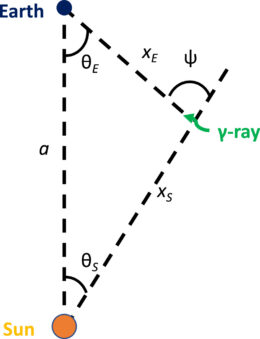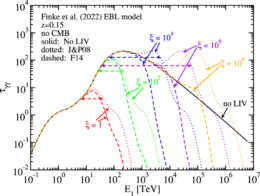One of the fundamental tenets of Einstein’s special theory of relativity is that the laws of physics are the same regardless of your vantage point. New research suggests a way to probe for cracks in this theory with a subtle measurement of gamma-ray photons.
Testing Special Relativity
Special relativity, which describes how mass, space, and time behave for objects moving close to the speed of light, has weathered every experimental challenge that researchers have thrown at it. A key edict of relativity is Lorentz invariance, or the idea that the laws of physics don’t vary from observer to observer. Other theories don’t hold Lorentz invariance so dear; some theories of quantum gravity, like string theory, allow for Lorentz invariance to be broken at very high energies.
If Lorentz invariance is violated — if the laws of physics do depend on your frame of reference — it opens the door to a host of bizarre effects. For one, the speed of light would not be constant, but would instead depend on the energy of the photon! In a recent research article, Justin Finke and Parshad Patel (US Naval Research Laboratory) explored another potential consequence of Lorentz invariance violation that could affect measurements of gamma-ray photons.

Schematic of the model showing the positions of Earth, the Sun, and incoming gamma rays. [Finke & Patel 2024]
Making Particles from Photons
Very rarely, two photons can interact to produce a particle and its antiparticle — for example, an electron and a positron. If Lorentz invariance is violated, it could change the likelihood of these rare photon–photon interactions and impact observations of distant gamma-ray sources.
Finke and Patel explored a possible way to search for Lorentz invariance violations by examining the interaction between gamma-ray photons from extragalactic sources and photons from the Sun. Their mathematical model describes the rate at which gamma rays interact with solar photons as a function of the gamma ray’s energy, the angle between the gamma-ray source and the Sun, and the energies at which Lorentz invariance is violated.
Identifying an Invariance Violation
The team found that the number of gamma rays that interact with other photons to produce particle–antiparticle pairs, called the absorption optical depth, can increase or decrease as a result of Lorentz invariance violation. Whether the optical depth increases or decreases depends on the energies of the interacting photons — in this case, solar photons. For interactions with solar photons, this effect potentially becomes important for incoming gamma rays with energies above 10 teraelectronvolts.

An example of how the absorption optical depth, τνν, can either increase or decrease relative to its behavior in absence of Lorentz invariance violation, depending on the photon energy. This example shows gamma-ray absorption by the extragalactic background light. Click to enlarge. [Finke & Patel 2024]
That’s how the measurement would work in theory — but could our present tools make it a reality? As of now, not in a reasonable time frame: given the sensitivity and observing limitations of current detectors, such as the High-Altitude Water Cherenkov Observatory, it could take more than 30 years to detect invariance violation, should it exist. If existing detectors could be tuned to distinguish between gamma rays and high-energy charged particles, it could shorten that time frame to as little as 1.3 years.
Citation
“Probing Lorentz Invariance Violation with Absorption of Astrophysical γ-Rays by Solar Photons,” Justin D. Finke and Parshad Patel 2024 ApJ 965 44. doi:10.3847/1538-4357/ad3212

